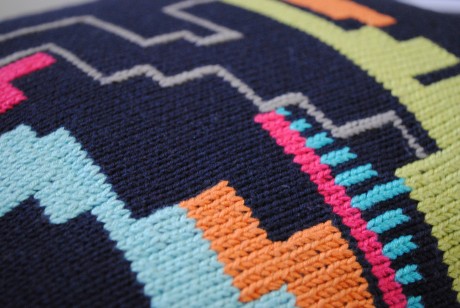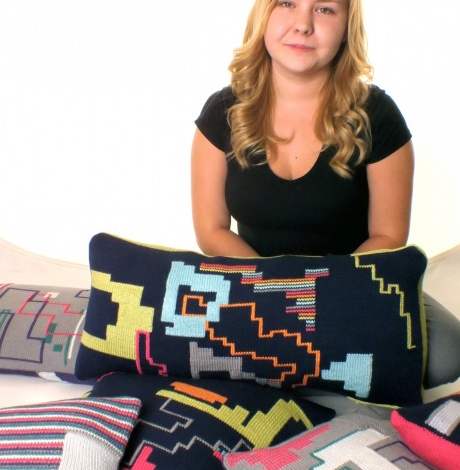Louisa Crompton is a textile designer who graduated with a first class BA in Textile Crafts from Huddersfield University, and was nominated for a Knitted Textile Award for her Rendered Reality designs. We caught up with her to find out all about her wacky designs, her use of colour, and what she has been planning next!
What have you been up to since graduating from Huddersfield?
I have been enjoying the chance to relax a little and pick up some of my old knitting projects. I have also been working on some designs for new cushions, and even branched out into fashion accessories such as scarves. In June I had the opportunity to exhibit my work at New Designers 2013 in London, and I was thrilled to meet many new faces and discuss my work with other people in the industry.
Tell us about the inspiration behind your Rendered Reality designs …
Rendered Reality was really about challenging myself and the use of colour within my knitting. Throughout my degree I struggled to use a lot of colour and would often reach for an Ecru wool or cotton with flashes of a muted colour such as green or brown. Rendered Reality was about producing something bright, bold and exciting. Having always been interested in the interaction of technology and design, I wanted to bring together the craftsmanship of traditional knitting methods and combine them with a contemporary digital aesthetic to produce designs that pop out at you!

How did you choose the colours?
As a designer I am heavily influenced by past, current and upcoming trends, so these are carefully considered when choosing my colours. I put together my designs on Adobe Illustrator and then produce yarn wraps and knitted samples before I am absolutely sure that the colours work together. Some days it will come to me in an instant. At other times I have found that it took a few weeks to get the colour combinations and portions just right.
How important do you think colour is for designers?
I believe that choosing and working with certain colours is such an important part of the design process. Even if the designer chooses to only work with monochrome colours, the variations in shade and intensity available to us is incredible and getting the right yarns or materials could change the design dramatically, whether it’s a cushion, garment or art piece. From experience I have found that really concentrating on the colours and having a little patience made the world of difference to my designs.

Why did you decide to Swiss darn the colourwork instead of using stranded or intarsia methods?
I enjoy the control that I have with Swiss darning – it’s like working with a blank canvas and a paint brush. Although I have a design and template, when I start I often change my mind - by using Swiss darning I can come back to any section at any time and simply unpick that area without unravelling the knitting. Swiss darning produces a layer on top of the fabric, which gives the designs a 3D element - I love how you can feel the shapes and lines when you run your fingers over the fabric. It makes the piece more interactive and fun! I also love the meticulous process of producing the stitches over and over again - I find it very therapeutic.
Why do you think knitting has become such a strong fashion trend? Is it here to stay?
I think that there is a huge demand for the handmade: something you can keep or give as a gift and what better way than to learn and make yourself? It’s something you can feel proud of and keep for many years. I certainly hope that it is here to stay, I won’t be abandoning my knitting needles, machine or yarn any time soon!
Which design trends are you looking forward to over the next few seasons?
I am definitely looking forward to the ‘New Digital Aesthetic’ trends forecasted by WGSN for Spring/Summer 2014. This was the main trend used when researching my Rendered Reality collection and I am excited to see how other designers interpret it too!

Do you have any tips for knitters who want to start experimenting more with colour?
Sometimes it really is worth taking the risk! Picking up three or four colours and playing around with the proportions can help you to decide which colours to keep and eliminate, which shades to change and so on. A useful experiment I picked up in my first year of uni is to mix five to seven colours with paint, grab some squared maths paper and a dice, then roll. If it lands on a four you will take the first colour and fill four squares. Roll the dice again, and fill in the next lot of squares with the second colour, and you will soon see that certain proportions work better than others. After this you can then move on to trying it with yarn!
What are you working on next?
I am currently working on getting my products online, creating some new designs and expanding my portfolio. It would be quite nice to try something different - I would love to work on some installation pieces, perhaps for use within shop window displays. I love taking on new and adventurous projects and having the chance to meet and work with new people!
Find out more about Louisa, and see what she’s working on next, by heading to www.louisacrompton.co.uk



_333_180_c1.png)


_Craftihive_Let_s_Knit_Website_Blog_-_7.9.25_HEADER_IMAGE-01__333_180_64_c1.jpg)

_333_180_64_c1.jpg)
 Baby
Baby
 Toys
Toys
 Garments
Garments
 Crochet
Crochet
 Homewares
Homewares
 Dolls
Dolls



Share